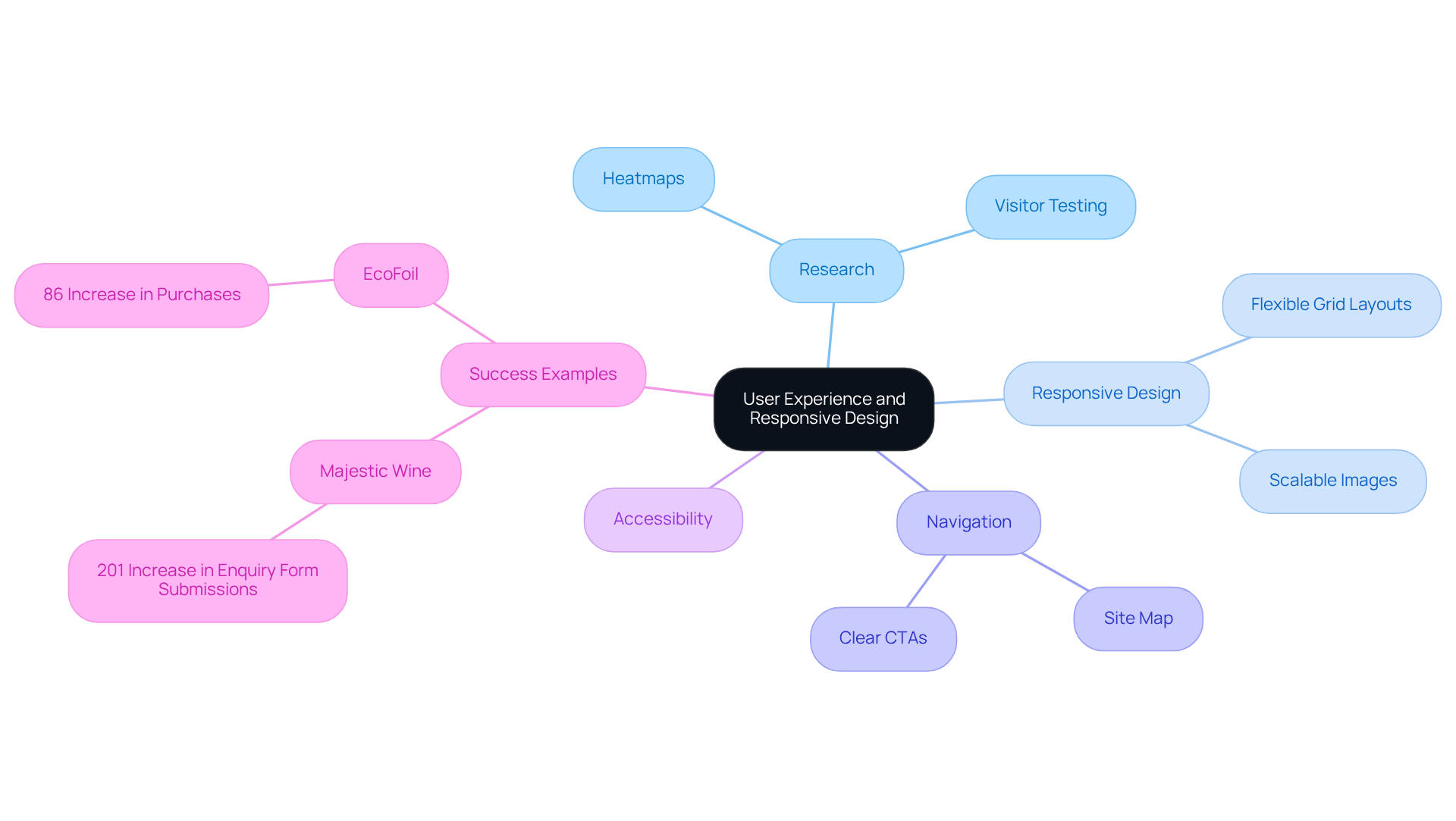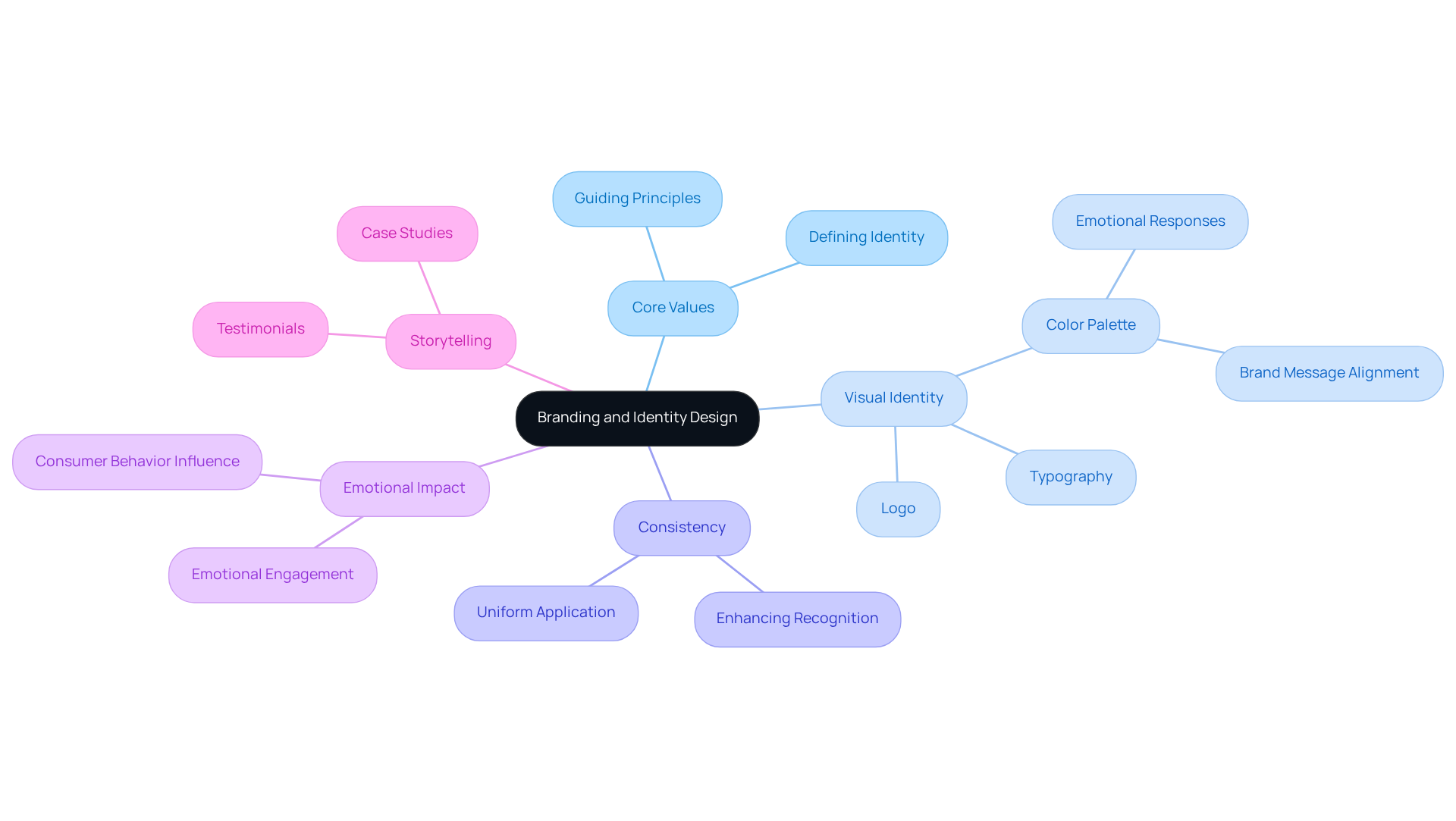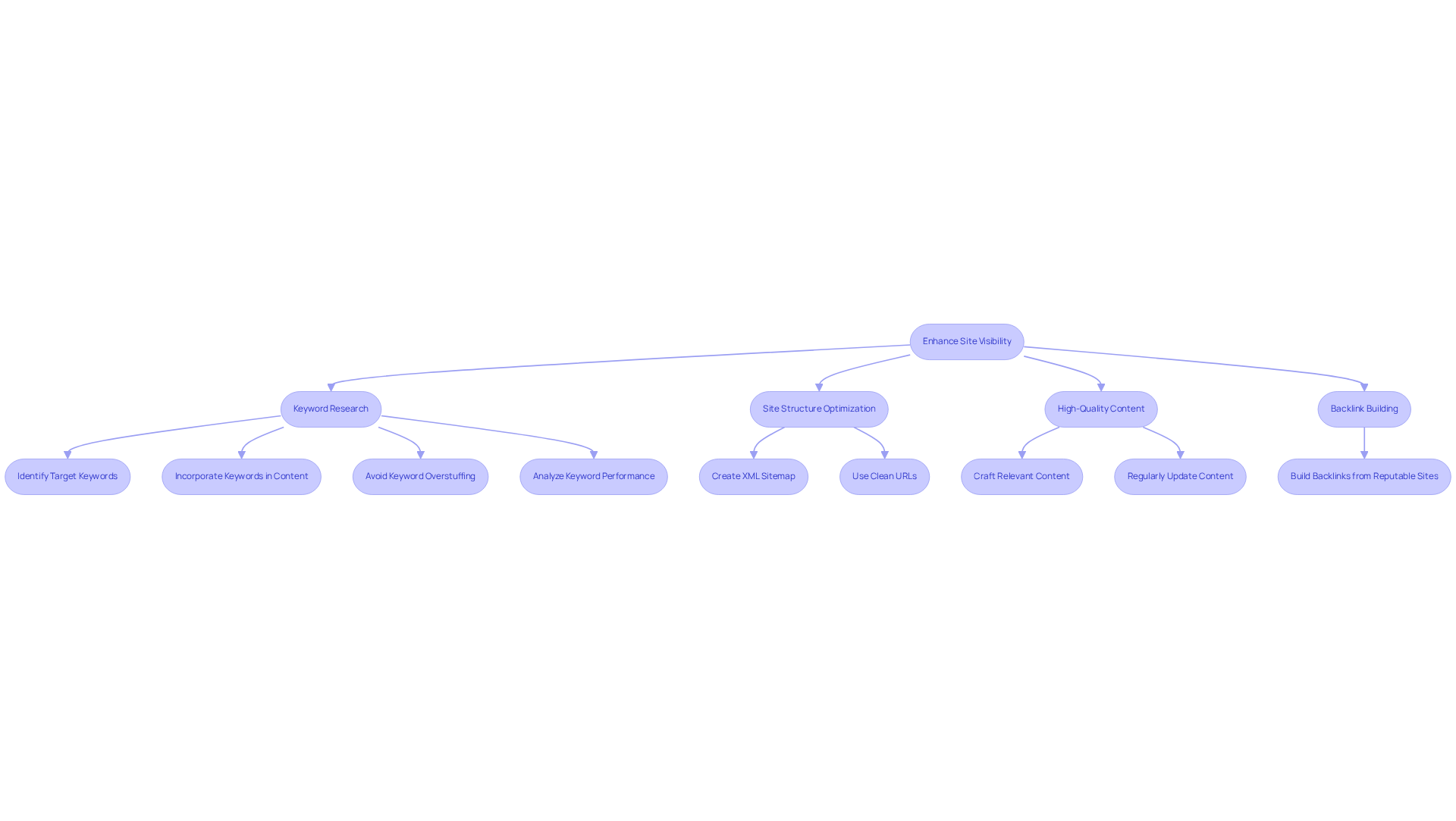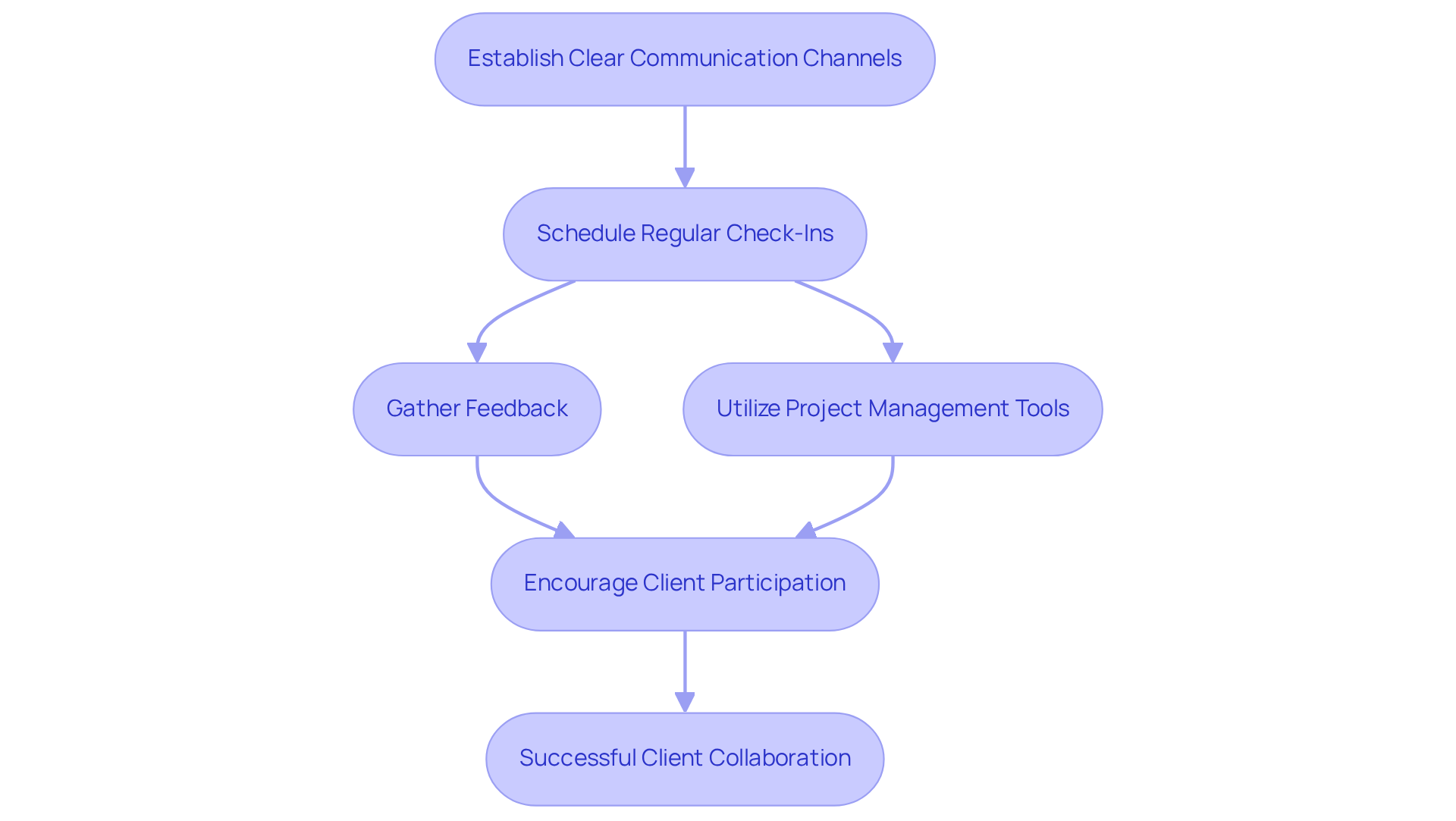Overview
This article presents four essential practices for effective web design in New York, emphasizing user experience, branding, SEO, and client communication.
Attention: In today’s competitive digital landscape, prioritizing user needs is paramount. By adopting responsive design, designers can ensure that websites function seamlessly across devices, enhancing user satisfaction and engagement.
Interest: Furthermore, integrating a strong brand identity is crucial. A well-defined brand not only attracts attention but also fosters trust and loyalty among users. Coupled with effective SEO strategies, which improve visibility in search engine results, these elements work together to create a compelling online presence.
Desire: Clear communication with clients is another cornerstone of successful web design. By fostering open dialogue, designers can better understand client goals and expectations, leading to more tailored solutions that resonate with target audiences.
Action: By implementing these best practices—focusing on user experience, branding, SEO, and client communication—designers can significantly enhance engagement and visibility. This approach not only drives success but also positions agencies as leaders in the digital space. Embrace these strategies today to elevate your web design efforts and achieve remarkable results.
Introduction
In the bustling landscape of New York's digital marketplace, effective web design is no longer a luxury; it’s a necessity. Businesses must navigate a myriad of strategies that prioritize user experience, branding, and search engine optimization to stand out in an increasingly competitive environment. This article explores four best practices that not only enhance a website's functionality but also elevate its overall appeal and visibility.
How can companies ensure their web design not only attracts visitors but also converts them into loyal customers? The answer lies in understanding the critical elements that drive engagement and conversion.
Prioritize User Experience and Responsive Design
To enhance the experience of individuals, begin with thorough research to identify the needs and preferences of your target audience. Tools like heatmaps and visitor testing provide valuable insights into navigation patterns, allowing for informed design decisions. A crucial element of this process is ensuring your design is responsive, adapting seamlessly to various screen sizes and orientations. Achieving this can be done through flexible grid layouts and scalable images, which are vital for maintaining usability across devices.
Streamlining navigation is equally important; reducing the number of clicks required to access essential information can significantly boost user satisfaction. Implementing a well-structured site map and clear calls-to-action (CTAs) effectively guides users, fostering deeper engagement with your content. Notably, websites with adaptable layouts experience 11% higher conversion rates, underscoring the significance of this approach.
As Frank Chimero wisely states, "Individuals overlook aesthetics that overlook individuals," highlighting the necessity of a user-centric design philosophy. Successful examples, such as Majestic Wine's website revamp, which led to a remarkable 201% increase in 'Enquiry Form' submissions, demonstrate how thoughtful adaptive layouts can drive substantial improvements in engagement and conversion rates.
Moreover, integrating accessibility features into responsive designs is essential to ensure that all users can navigate and interact with your site effectively. By prioritizing these elements, you not only enhance user experience but also position your brand for greater success in a competitive landscape.

Integrate Strong Branding and Identity Design
To effectively incorporate branding into your website layout, begin by clearly defining your identity's core values and personality. These insights will guide your visual identity, encompassing logo creation, color palette, and typography. Consistency across all pages is crucial; ensure these elements are uniformly applied to enhance recognition. Consider the emotional impact of your choices, as colors can evoke specific feelings—select a palette that aligns with your brand's message.
Moreover, weave storytelling elements into your design, such as case studies or testimonials, to cultivate a deeper connection with your audience. Research indicates that emotionally engaging designs can significantly influence consumer behavior, with emotional advertisements driving a 23% increase in sales. By prioritizing emotional design and brand identity, you can craft an online platform that not only attracts visitors but also converts them into loyal customers. Take action now—elevate your brand's presence and watch your engagement soar.

Implement SEO Best Practices for Enhanced Visibility
To enhance your site's visibility, begin with thorough keyword research to identify the terms and phrases your target audience is actively searching for. Strategically incorporate these keywords into your content, meta descriptions, and headers. Recent statistics reveal that 53% of all internet traffic stems from online searches, highlighting the pivotal role of keyword research in driving organic traffic.
Next, ensure your site's structure is optimized for search engines. Utilize clean URLs, appropriate heading tags, and an XML sitemap. Focus on crafting high-quality, relevant content that addresses your audience's needs and questions. Regularly updating your content not only keeps it fresh and engaging but also aligns with the belief of 70% of marketers that SEO yields better results than pay-per-click (PPC) advertising.
Consider building backlinks from reputable sites to bolster your site's authority and ranking. Effective link-building is a cornerstone of any successful SEO strategy, with 80% of SEO professionals deeming it essential. As an SEO expert aptly stated, "High-quality backlinks are vital for improving your site's visibility and credibility in search engines."
By prioritizing these keyword research strategies, you can significantly boost your site's visibility and attract more organic traffic. Avoid common pitfalls such as keyword overstuffing or neglecting to analyze keyword performance regularly. In conclusion, effective keyword research not only enhances your website's visibility but also contributes to your overall marketing success.

Foster Collaboration and Clear Communication with Clients
To foster collaboration, establishing clear communication channels from the outset is crucial. At Overskies, we prioritize proactive communication to ensure our creative content production services align seamlessly with your vision. By scheduling regular check-ins and updates, we can discuss progress and gather feedback, effectively preventing small concerns from escalating into major issues.
Research shows that effective client communication significantly enhances project success rates. Proactive strategies not only reduce client churn but also minimize scope creep. Utilizing project management tools like Slack for daily check-ins and Figma for creative collaboration enhances transparency, ensuring all stakeholders remain informed and engaged throughout the process.
Encouraging clients to share their ideas and preferences builds trust and ensures the final product reflects their unique brand narrative. For instance, during a recent project, we engaged clients in brainstorming sessions that led to innovative solutions, significantly boosting their investment in the project. As Jake Davis emphasizes, adopting a user-focused approach and incorporating regular user testing are vital for achieving successful outcomes.
By leveraging our flexible solutions for video, design, and digital marketing, we craft compelling visuals that elevate your brand's story. Implementing these communication strategies can lead to improved client satisfaction and project results. Let's collaborate to bring your vision to life.

Conclusion
Effective web design is not just a necessity; it’s a powerful tool for creating an engaging and user-friendly experience that truly resonates with visitors. By prioritizing user experience, integrating strong branding, implementing SEO best practices, and fostering collaboration, businesses can significantly elevate their online presence and drive meaningful engagement.
Key insights from this article underscore the critical importance of understanding target audiences and their needs through thorough user research and responsive design. A cohesive brand identity not only enhances recognition but also fosters emotional connections with users. Moreover, effective SEO strategies are essential for improving visibility and driving organic traffic. Clear communication with clients is equally vital, as it fosters collaboration and ensures that the final product aligns seamlessly with their vision and goals.
In today’s rapidly evolving digital landscape, embracing these best practices is essential for businesses aiming to stand out and succeed. By focusing on user-centric design, effective branding, and strategic visibility efforts, organizations can attract visitors and convert them into loyal customers. Now is the time to take action and enhance your web design; doing so will pave the way for sustained growth and success in an increasingly competitive market.
Frequently Asked Questions
What is the first step in enhancing user experience on a website?
The first step is to conduct thorough research to identify the needs and preferences of your target audience.
What tools can help in understanding user navigation patterns?
Tools like heatmaps and visitor testing provide valuable insights into navigation patterns.
Why is responsive design important?
Responsive design is important because it ensures that the website adapts seamlessly to various screen sizes and orientations, maintaining usability across devices.
How can responsive design be achieved?
Responsive design can be achieved through flexible grid layouts and scalable images.
What impact does streamlining navigation have on user satisfaction?
Streamlining navigation by reducing the number of clicks required to access essential information can significantly boost user satisfaction.
What are effective strategies for guiding users on a website?
Implementing a well-structured site map and clear calls-to-action (CTAs) effectively guides users and fosters deeper engagement with content.
What is the correlation between adaptable layouts and conversion rates?
Websites with adaptable layouts experience 11% higher conversion rates, highlighting the significance of responsive design.
Can you provide an example of a successful website redesign?
An example is Majestic Wine's website revamp, which led to a remarkable 201% increase in 'Enquiry Form' submissions.
Why is integrating accessibility features important in responsive design?
Integrating accessibility features is essential to ensure that all users can navigate and interact with the site effectively.
How does prioritizing user experience benefit a brand?
By prioritizing user experience, a brand enhances user engagement and positions itself for greater success in a competitive landscape.
.png?width=250&height=153&name=CSI-OverskiesRebrand_LOGO-01(smaller).png)

.png?width=100&height=61&name=CSI-OverskiesRebrand_LOGO-01(smaller).png)


.png?width=88&name=CSI-OverskiesRebrand_LOGO-01(smaller).png)



